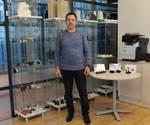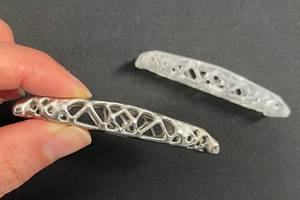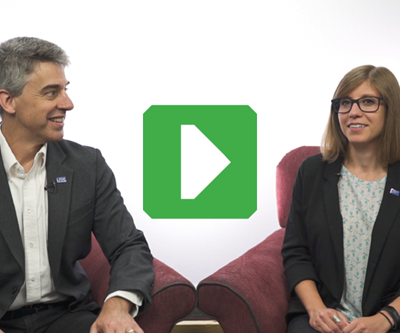Jabil Emerges as a Powerhouse in Additive Manufacturing
Jabil, an international force in manufacturing, software and services, has launched a global network of additive manufacturing services.
Late April saw the entrance of a heavyweight amid the handful of much smaller companies staking out the new territory of industrial additive manufacturing (AM). Jabil, a $19 billion global enterprise with around 180,000 employees and over 100 facilities in 29 countries, announced the launch of the Jabil Additive Manufacturing Network as a “digital thread” to connect its additive manufacturing operations around the world, including those at its subsidiaries Nypro and Jabil Green Point, while aligning with Jabil’s software and services for supply-chain management, product development, and engineering/design.
Jabil, which operates 15,000 CNC mills along with thousands of injection machines and hundreds of automated printed-circuit assembly lines, got involved with additive manufacturing about a decade ago, using it to print metal mold components with conformal cooling, as well as assembly jigs and fixtures, for its core manufacturing operations.
About three years ago, Jabil began taking AM into functional parts manufacturing. Today, the Jabil Additive Manufacturing Network, based at Jabil headquarters in St. Petersburg, Florida, has more than 100 3D printers in around a dozen plants in the U.S. (four facilities), Mexico, China, Singapore, Hungary and Spain.
Jabil’s AM technologies include fused filament fabrication (FFF), polymer and metal laser sintering, and the new Multi Jet Fusion (MJF) high-speed sintering process from HP. There are six HP Jet Fusion 4200 printers and six of the newest Jet Fusion 4210 models installed recently in Singapore, the newest of Jabil’s AM Network sites, according to John Dulchinos, Jabil’s vice president of digital manufacturing.
Agile Manufacturing
Jabil Additive is aiming to serve customers in markets such as footwear, industrial machinery, transportation, aerospace and healthcare. In Jabil’s view, AM might as well stand for “agile manufacturing.” A cloud-based network integrates all Jabil’s 3D printers around the globe, enabling customers to move manufacturing workloads to regions and into markets that make the most business sense and enable easier product personalization. As Dulchinos puts it, “Our new Jabil Additive Manufacturing Network is the connective tissue that scales globally to integrate every printer, facility and work order across our enterprise and crystallize our vision of truly distributed manufacturing.”
Dulchinos distinguishes Jabil’s Network from other AM enterprises: “We’re not about uploading a customer’s CAD file and sending back a printed part or parts. We’re about certified manufacturing processes for producing functional parts in quantities of tens of thousands.”
He notes that Jabil has a product-design team in Silicon Valley, California, that can design a product from an initial concept, if necessary. But if the customer comes to Jabil with an existing product design, the first step is to consult with Jabil’s customer content engineers to examine the customer’s CAD file and perform a design for additive manufacturing (DFAM) analysis.
The goal is to optimize the design for 3D printing rather than injection molding or another process. That could include tweaking the design to allow multiple different components of an assembly to be printed as one part.
DFAM is followed by consideration of the AM process to be used, inspection procedures and part qualification—as is done with injection molding or any other manufacturing method. “We are a certified manufacturer of 3D-printed parts across industries, from aerospace to consumer products,” he notes.
Dulchinos says AM benefits from “mold-less, fixture-less production” and the speed with which products can be put into production at any of its global facilities. “It’s true just-in-time manufacturing. There’s no need for inventory.”
For example, in Singapore, Jabil uses HP Multi Jet Fusion printers to produce 140 discrete parts for HP’s newest Jet Fusion Series 300 / 500 printers—in the very same building where Jabil assembles those printers for HP. “In a single bed on the printer, we can produce a kit of multiple parts all at the same time,” Dulchinos notes.
On the other hand, he also points out three main constraints that currently limit the spread of industrial AM. “The range of materials available for AM is the biggest constraint,” he states, but HP is loosening that constraint through its open materials platform that encourages thermoplastic materials suppliers to adapt their materials for HP’s printers and provides guidance and other resources for doing so. The range of filament materials for AM is also growing steadily.
More than 100 3D printers across the globe are integrated via cloud-based production and order management.
The second major constraint, according to Dulchinos, is economics. He says the costs of 3D printing divide about evenly between material, equipment depreciation and service, and secondary processes (including labor). Today, he sees the “sweet spot” for Jabil Additive at order volumes of 10,000 to 30,000 parts. “But that’s very geometry-sensitive. At the extremes, some parts may be cost-effective today in volumes up to 40,000 to 50,000 parts, and others at as few as 1,000 parts.” Not only is 3D printing economically competitive with injection molding at those volumes, Dulchinos says, but he believes HP’s Multi Jet Fusion is “starting to approach the isotropic properties of injection molded parts—within single-digit percentages.”
The third key constraint, in Dulchinos’ view, is “the ability to get consistent, repeatable, parts off printers. It’s not a given, but requires manufacturing rigor. That’s how we got to be a certified AM manufacturer in demanding industries such as aerospace.”
While AM is gradually encroaching on injection molding in low-to-mid-volume production, Dulchinos sees it as augmenting rather than cannibalizing Jabil’s ample injection molding resources. It enables Jabil to offer customers new choices for optimized production efficiency. He cites the example of a medical-equipment display housing that originally required assembly of 39 injection molded plastic parts and metal fasteners. Jabil redesigned the housing as just two plastic parts that can be printed together. This display is expected to go into production this summer and the anticipated volume is in the thousands of units.
This article originally appeared on Plastics Technology magazine's website.
Related Content
Possibilities From Electroplating 3D Printed Plastic Parts
Adding layers of nickel or copper to 3D printed polymer can impart desired properties such as electrical conductivity, EMI shielding, abrasion resistance and improved strength — approaching and even exceeding 3D printed metal, according to RePliForm.
Read MoreConcept Sneaker Boasts One-Piece 3D Printed TPU Construction
The Reebok x Botter Concept Sneaker Engineered by HP premiered at Paris Fashion Week, hinting at manufacturing possibilities for the future of footwear.
Read MoreFDA-Approved Spine Implant Made with PEEK: The Cool Parts Show #63
Curiteva now manufactures these cervical spine implants using an unusual 3D printing method: fused strand deposition. Learn how the process works and why it’s a good pairing with PEEK in this episode of The Cool Parts Show.
Read More3D Printed Spine Implants Made From PEEK Now in Production
Medical device manufacturer Curiteva is producing two families of spinal implants using a proprietary process for 3D printing porous polyether ether ketone (PEEK).
Read MoreRead Next
AM at Jabil: From 3D Printing Materials to Distributed Manufacturing
One of the largest manufacturers in the world has made a significant investment in 3D printing — both as a user and an advancer of this technology. Our original reporting dives into the what and why of additive manufacturing at Jabil.
Read MoreAdditive Manufacturing: HP Announces Lower-Cost Jet Fusion 3D Printers for Prototyping—in Full Color
Lower cost, more compact models for low-volume prototyping also introduce full-color 3D printing.
Read MoreHow to Implement Additive Manufacturing Across a Global Company: 5 Lessons
With more than 100 facilities and about 200,000 employees worldwide, Flex has a steep challenge in bringing 3D printing into its operations. Five things the company is learning.
Read More




















